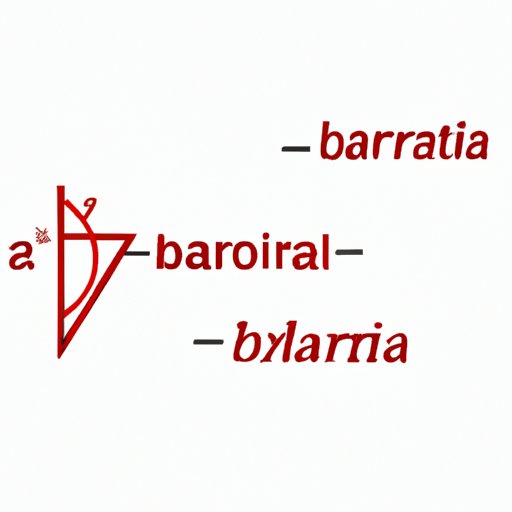Introduction
A parabola is a U-shaped curve that is commonly found in mathematics, physics, and engineering. Understanding how to find the vertex of a parabola is important for solving optimization problems and modeling real-world situations. In this article, we will provide a step-by-step guide on how to find the vertex of a parabola, discuss its applications in real life, and offer a variety of tips and tricks to streamline the process.
Step-by-Step Guide
The vertex is the minimum point (for upward-opening parabolas) or maximum point (for downward-opening parabolas) of the parabolic curve. It is located at the point where the parabola changes its direction. To find the vertex, we can use a three-step formula:
- Identify the values of a, b, and c in the quadratic equation y = ax^2 + bx + c.
- Calculate the x-coordinate of the vertex using the formula -b/2a.
- Calculate the y-coordinate of the vertex by substituting the x-coordinate into the equation y = ax^2 + bx + c.
Let’s say we have the quadratic equation y = 2x^2 + 8x + 6. Firstly, we can identify the values of a, b, and c: a = 2, b = 8, c = 6. Then, to find the x-coordinate of the vertex, we use the formula -b/2a: -8/2(2) = -2. Finally, we substitute the x-coordinate (-2) into the equation y = 2x^2 + 8x + 6 to find the y-coordinate of the vertex: y = 2(-2)^2 + 8(-2) + 6 = -4.
Therefore, the vertex of the parabola y = 2x^2 + 8x + 6 is (-2, -4).
It is important to note that if the value of a is negative (i.e., the parabola opens downwards), then the y-coordinate of the vertex will be the maximum value of the curve rather than the minimum.
Applications in Real Life
The knowledge of parabolic curves and their vertices is useful in a wide range of real-world scenarios. For example, optimization problems in business and economics often require finding the maximum or minimum point of a parabolic function. Projectile motion, such as the trajectory of a soccer ball or a missile, can also be modeled using parabolic equations with the vertex representing the highest point of the flight.
In physics and engineering, knowledge of parabolic functions can be used to model wave patterns, sound and light reflections, satellite orbits, and more. Understanding the vertex of a parabola is essential in making accurate predictions and designing efficient systems.
Interactive Online Tool
An interactive online tool can guide users through the steps of finding the vertex of a parabola in a user-friendly way. The tool typically requires users to enter the values of a, b, and c in a web form, and then automatically calculates the x and y coordinates of the vertex.
One example of such a tool is available on the Math Warehouse website. This tool provides a visual representation of the parabolic curve and allows users to adjust the values of a, b, and c using sliders. The tool then dynamically updates the graph and displays the location of the vertex in real-time. This kind of interactive tool can be especially helpful for learners who prefer to have a visual aid while learning new concepts.
Tips and Tricks
There are several tips and tricks that can help make finding the vertex of a parabola faster and easier:
- Convert the quadratic function to vertex form by completing the square, which makes finding the vertex effortless. For example, convert y = x^2 – 6x + 13 to y = (x – 3)^2 + 4.
- Remember that the x-coordinate of the vertex is always -b/2a, regardless of the form of the quadratic function.
- Graph the parabola to get a visual representation of the curve and its vertex. This can be done by plotting points or using a computer program like Desmos or Geogebra.
- Avoid common mistakes such as forgetting to divide -b by 2a, or confusing the order of operations when plugging in values.
Videos
Video tutorials can be an effective way to learn how to find the vertex of a parabola. They allow learners to see the steps in action and can provide additional insights and examples.
Two excellent videos that cover this topic are “How to Find the Vertex of a Parabolic Function” by MathMeeting and “Finding the Vertex of a Parabola” by Khan Academy. Both videos provide clear explanations of the concept and offer detailed examples of how to apply the formulas to solve different problems.
Conclusion
Finding the vertex of a parabola is a fundamental concept in algebra, geometry, and calculus. Its ability to model real-world situations and optimize decision making make it an essential skill for learners of all fields. By following the steps outlined in this article, utilizing online tools, and incorporating tips and tricks, anyone can master the art of finding the vertex of a parabola.
